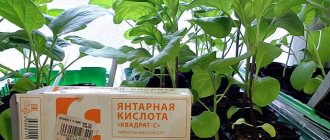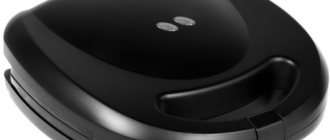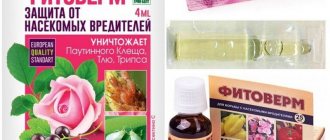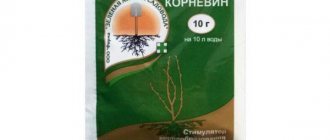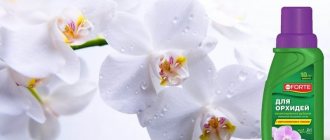To maintain a beautiful, lushly flowering garden or fruitful vegetable garden, gardeners use many types of organic and chemical fertilizers. You can buy the product at any agricultural produce store. But there are plants that require no less love and care. In the same way, owners of indoor flower beds want to have beautiful, green plants in pots.
Succinic acid is suitable for this. The product is gaining popularity and winning the hearts of flower growers with its magical art of quickly restoring decorative plantings. Reviews from people who use the fertilizer with such an interesting name in practice are positive. Because the substance is safe and effective.
Characteristics and composition
Succinic acid is not sold in stores selling agricultural products. It is purchased at a pharmacy. The release form is different, but the chemical name is the same - butadienic acid.
The substance is used in practice as a medicinal form to restore the immune and nervous systems, filling them with energy. Has various areas of application. Doctors recommend using it for:
- improving brain function;
- to increase attention and concentration;
- strengthening reflexes;
- relieving stress from the body and nervous system.
The formula of succinic acid is designed in such a way as to relieve inflammatory processes and prevent the appearance of tumors, restore blood circulation and veins.
In a similar way, amber helps plants recover. The immune system is imbued, which means photosynthesis improves. It will help improve the condition of not only indoor plants, but also in the country.
Succinic acid is not a chemical substance, but an organic one. You can find it in cheeses, gooseberries and grapes. Sauerkraut has become a storehouse of this substance. Naturally, amber itself is the main source material for acid.
Modern science manages to obtain the composition of succinic acid using the formula of n-butane and benzene. By combining the two components, crystals are obtained and then ground into powder (white color). Taste: sourish taste. At the same time, the crystals dissolve well in water.
Auxiliary components are:
- potato starch and talc;
- aerosil and sugar;
- ascorbic acid and calcium stearate.
Preparation of the solution
To make it easier to prepare the solution, first make a 1% concentrate. To do this, dissolve the tablet in a glass of water, then adjust the volume to 1 liter. To obtain a solution of the required concentration, that is, 0.002%, you need to dissolve 1 tablet in 10 liters. If you add, for example, not 10 liters, but 9 or 8, there will be no problems.
Another option for home use: 2 g of pure substance (powder or tablets) is dissolved in a small amount of warm water, and then the amount of solution is adjusted to 1 liter with water at room temperature. Dry seeds are soaked in this solution for 12-24 hours, then dried on dry material in the shade and sown in the prepared substrate.
Fertilizer properties
The chemical properties of amber are clearly beneficial for the treatment of human ailments. In practice, the medicine began to bring positive reviews in gardening and when propagating indoor plants.
Succinic acid becomes a growth stimulator for plants. Purchased in the form of tablets or injection liquid, diluted in water and used for spraying or watering. The positive aspects of processing are:
| Benefit | Specifics |
| Sustainability | A plant treated with acid, even in small quantities, is not afraid of frost, humidity or drought. Gains increased stability and protection |
| Root formation | If necessary, replanting the plant and stopping the roots becomes an indispensable tool. Helps to revive, propagate and replant without problems |
| Chlorophyll | This substance is produced twice. Due to this, flowers and garden crops acquire improved color and are filled with vital energy. |
| Stimulant | When plants are treated with amber, the root system improves and absorbs added bioadditives from the soil faster. Growth accelerates and appearance improves |
| Destruction of toxins | Toxins and other negative substances always accumulate in the soil. But when treated with succinic acid, toxic elements dissolve |
| Increased adaptability | If the flower is sick, then using amber is simply necessary. It will help the plant’s immunity to protect itself from negative bacteria, microbes, and fungi. In addition, it will recover faster after an illness. |
| Microflora | After treatment, the activity of positively charged particles is balanced, which clearly improves the quality of soil microflora |
Vitamins needed for healthy growth and flowering
Indoor flowers are the pride of any housewife. She rejoices at how they grow and bloom. In order for the plant to remain healthy and attractive for a long time, it needs vitamins.
IN 1
The vitamin helps the plant survive stress; if it is deficient, the growth of the plant slows down, the leaves lose their color and healthy appearance. Flowers are fed with a solution in the proportion: 1 ml per liter of water. B1 decomposes when exposed to sunlight, so it is better to spray it in the evening. The excess does not accumulate, so there is no fear of overdose.
AT 2
Performs the function of strengthening the plant’s immune system, giving strength to resist various bacteria.
AT 3
Recommended for use together with B1 and B6, in the same proportion. Nicotinic acid (vitamin B3) is the only vitamin involved in hormonal metabolism. Thanks to this property, it can rejuvenate the plant, stimulate flowering and the appearance of new shoots. The vitamin is resistant to temperature changes and ultraviolet radiation.
AT 6
An indispensable vitamin for boosting immunity, it is recommended to be used when it is necessary to “exit” wilted and sick representatives of the home flora.
AT 12
The vitamin takes an active part in the production of chlorophyll and charges the plant with energy. The composition contains cobalt, which allows plants to be well saturated with oxygen. Relevant in winter, when there is not enough sunlight and the room is rarely ventilated.
WITH
Ascorbic acid protects the plant from chlorosis and increases growth.
All vitamins are diluted in the proportion of 1 ml per liter of water.
Pros and cons of using
The effect of acid on a plant is more like a growth stimulator. At the same time, using the medicine as a fertilizer has additional advantages:
- Stabilizes soil microflora and helps plants resist diseases.
- The stimulating effect of succinic acid does not end there. The growth stimulator improves the plant's immunity and prevents fungal and bacterial infections from damaging green spaces.
- Reduces stress factors: pressure surges, temperature problems, drought or high humidity, lack of lighting.
Indoor flowers suffer the most from stressful situations. The soil in pots changes and is associated with human actions that are unpleasant for the plant. The roots are always damaged and exposed when transplanted.
It's difficult to experience so much at once. The plant experiences particular challenges during periods of drought or rainy weeks. Humidity and dryness of the air also greatly hinder the “green inhabitants” from growing and looking healthy.
The benefits and harms of succinic acid in the analysis are huge among the negative aspects: increasing the dose leads to unpleasant consequences. The plant should not be over-fertilized. But if it is necessary to combat chlorophyll, succinic acid becomes an emergency aid.
Release form and production features
Butadienic acid is sold in pharmacy kiosks as a medicine. Amber water is prepared independently at home using a purchased pharmaceutical preparation.
Sold as an injection liquid in ampoules, tablets or powder form. All forms that are commercially available are suitable as fertilizer.
The tablets are amber or in powder, but the succinic acid is compacted and dry. It dissolves well in water, which allows you to quickly prepare liquid for feeding. The ampoule product is popular. Since it is enough to add it to water and stir for less than a minute. All. The product is ready without much effort.
Regardless of the type (tablets, ampoules, powder), the composition is the same, only the dosage of the main components is slightly changed. Therefore, before starting watering, you need to clarify the recipe and method of diluting the drug.
How to choose fertilizers for indoor flowers
Indoor plants grown in homes require regular feeding.
As a rule, multicomponent complex fertilizers, which are available in garden stores, are used for these purposes.
Finished products are usually sold in concentrated form and often contain synthetic components of various origins, so when used you can easily make a mistake with the dosage.
In addition, the amount of substrate in pots is very limited and, as a result of improper fertilizing, its structure can easily be changed. For this reason, many gardeners advise using environmentally friendly homemade fertilizers for indoor flowers.
The effect of fertilizer on soil and plants
Amber fertilizer is an excellent tool for destroying bacteria and restoring the plant with the necessary microelements. Acid is suitable in various situations that arise in a country house or garden, or in an apartment.
If the effect of succinic acid on houseplants is quite clear - stress relief, restoration of immunity.
This begs the question: can it be used as a fertilizer for cucumbers, tomatoes or other vegetable crops? To understand this, it is worth studying in detail why and how you can use the drug.
It is suggested to use amber water from the stage of plant development: seeds. Treatment is carried out before direct sowing. To do this, prepare a 0.2% solution (dissolve 2 mg or one tablet in 1 liter of water), soak the seeds.
Potassium permangantsovka
Potassium permanganate has a beneficial effect on indoor flowers, as it has many uses:
- Suppression of putrefactive processes - roots and tubers are treated for 15–20 minutes before planting.
- Preventing the proliferation of pests by spraying.
- Disinfection of above-ground parts of plants, soil and working tools.
- Stimulation of the ovary and increase in fruit quality on domestic fruit crops. To do this, make a nutrient solution in 5 liters of water from 1 g of potassium permanganate, 1 g of boric acid and 2 tbsp. l. ash.
- Activation of cutting growth and seed germination. Planting material is soaked in a pale pink liquid for 40–50 minutes. When propagating a plant by layering, draining the rooting site will additionally stimulate the growth of the underground part.
- Use for obvious lack of microelements potassium and magnesium. This is expressed by the absence of buds or their falling off, yellowing and curling of the leaves.
For prevention, potassium permanganate is used no more than once every six months. For active infection, apply once a week. The concentration of the drug depends on the purpose:
- for spraying, dissolve 1 g in 5 liters of water so that the color is almost transparent;
- to disinfect the soil, dilute 3–4 g in 5 liters of water;
- to disinfect planting material, prepare a solution of 0.5 g and 100 ml;
- the nutritional mixture consists of 1.5–2 g and 5 liters of water.
Features of use for indoor plants
Home floriculture is much more complicated than it seems at first glance. In apartment conditions, where there is less fresh air, there are much more stressful situations for plants.
The destruction of bacteria, fungus and other diseases is more difficult. To strengthen the immunity of the indoor “dweller” and speed up the growing season, it is amber liquid that is recommended.
For indoor flowers, succinic acid is especially necessary when there is overheating or excessive humidity. It is always difficult to choose feeding and fertilizer for the “delicate creatures of the window sill”. But amber compensates for the lack of vitamins and nutrients in the soil.
If a person is a happy owner of tropical plants (for example, orchids), it is worth remembering the need for special treatment and care for flowers. Feeding orchids with succinic acid will help improve health and activate photosynthesis. It will also stimulate the formation of flower stalks.
This plant often suffers from rotting roots. Productive treatment and stress relief can be carried out with a weak solution. To do this, you will need to dilute the orchid tablet in 5 liters of warm water.
This solution is recommended for frequent use. Spray once every 21 days. As soon as the product runs out, the remains are poured into the soil. Systematic application allows you to protect orchids from diseases, rot and other negative aspects.
If a florist is passionate about roses, use acid like street pink beauties. The only thing worth remembering is that rose flower beds at home are more delicate. Spraying is allowed once a month, and application to the soil once every 2 months.
Feeding methods
Experienced gardeners use various methods to feed plants. Some people prefer spraying, others add the prepared solution to the water for irrigation. It is necessary to take into account not only preferences, but also the situation in which feeding occurs.
Spraying on leaves
There are rules that must be followed when feeding plants with vitamins. Hard tap water has an adverse effect on the soil and clogs the air passages of the leaves. When watering with unsettled water, white spots and stains remain on the foliage. Therefore, the water must be left to stand for at least 2-3 days. Rainwater and filtered water are of great benefit.
Not all plants like water treatments, especially for flowers that have fibers on their leaves. These are violets and gloxinias. And coniferous vegetation dies without spraying the leaves.
When carrying out the procedure, you must adhere to certain rules:
- Do not spray the plant in direct sunlight; it is better to do it early in the morning or in the evening;
- Spraying should be carried out after watering;
- plants with fleshy leaves are treated on both sides;
- Cacti should be handled with care.
In this way, it is good to feed with aspirin, succinic acid, and B vitamins.
Root
Root feeding is the leader among ways to saturate a home plant with vitamins. Direct contact of the vitamin composition with the root gives quick results. The root is the basis of plant life. Substances that enter the root system spread throughout the plant and nourish it.
The only thing you need to remember: an overdose of the product can adversely affect the health of the plant, or even destroy it. If the concentrated solution gets on the foliage, it will destroy only part of the plant, and root feeding without observing the dosage will destroy the plant completely.
Soak
To carry out the soaking procedure, you need to prepare one or more containers in which the plants will be placed. It is recommended to soak each one in a separate container. If it is impossible to organize soaking at the same time, then the solution must be changed and the container washed after each plant. This rule can be ignored only if there is confidence that the bacteria will not pass from one to another, that is, all representatives of the home flora are absolutely healthy.
Soaking is carried out from 15 minutes to half an hour, after which the entire vitamin cocktail is drained, leaving no residue.
Watering
Water the plants with the vitamin solution carefully, strictly observing the dosage. Otherwise, instead of being saturated with vitamins, the plant will receive stress, which can destroy it completely. Watering is carried out with settled water with the addition of a pre-prepared vitamin solution. Water should get under the root of the plant, and in case of watering with potassium permanganate, do not touch the root system.
When watering with vitamins, avoid accumulation of water in the pan. Excess liquid must be drained immediately.
In addition to pharmaceutical drugs, vitamins are found in ordinary waste. This:
- tree resin, the solution of which is prepared simply: 25-30 g is poured into a liter of boiling water, infused for a week and the plant is watered once every 10 days;
- for plants, especially cacti, sweet water is suitable, prepared at the rate of 1 teaspoon of sugar per 1 glass of water;
- Citrus peels and banana peels are used for water infusions.
It must be remembered that not only vitamins are important for the health of plants, but also daily care: watering in accordance with the needs of the plant, timely replanting, extermination of pests, determining the location so that there is enough sunlight.
Operating instructions
There are no instructions for using succinic acid for plants. And it is impossible to see it in a box of pills or powder. Standard dilution is to add 0.1 g of powder (tablet) to warm water.
In tablet form it can be 0.25 g. In this case, you need to add 4 tablets at once. The moment of direct use is taken into account: to improve flowering, as flower food or as medicine.
Dosage
The dosage of succinic acid depends on the direction of application. But the drug has an effect even at low doses. Weak solutions are prepared at the rate of 1 tablet per 1 liter. Suitable for wiping the green part to improve photosynthesis, for treating sensitive plants.
Fertilizer for abundant flowering of indoor flowers
Every gardener who grows “green pets” wants to see lush flowering buds. There are a lot of flowering indoor plants. Among them are anthurium, camellia, clerodendrum, sinningia, alpine violet and others. However, it happens that home crops bought from the shelves in flower shops drop their buds at home, refusing to bloom.
There are many reasons for this behavior of plants: changes in microclimate, replanting, improper care, lack of lighting, lack of fertilizing. To bring the flower back to normal, specially developed fertilizers come to the rescue, designed to stimulate the formation of new buds, as well as the growth of the crop.
Plant treatment methods
It is recommended to use the amber liquid in several ways. They are also suitable for floriculture and gardening. The most common methods are watering and spraying. But amber will also be useful for:
- wiping the green part;
- soaking the roots before planting or between the process of replanting into another pot.
Soak
Succinic acid for seeds, seedlings, cuttings, tubers, root systems should be prepared in low concentration. If it is necessary to quickly obtain results, the solution is mixed for 2 days at the rate of 0.4 g per 1 liter.
No matter how the soaking occurs, after it the planting material is dried and then planted in the soil . If germination began during soaking, planting occurs immediately.
In the garden, succinic acid has the same application as in floriculture.
Spraying
The use of succinic acid for seedlings makes it possible to fill the young plant with energy and strengthen the immune system. The spray liquid works as a growth stimulator for plants.
The method involves processing the biomaterial in the morning or after sunset. Avoid exposure to sunlight during spraying, as you can burn the leaves, stems and shoots.
The procedure is done either with a weak solution (the flower is healthy, but requires a little life-giving moisture), or the solution is mixed with 0.03%. The exception was grapes. The vine is treated with a 0.08% solution of succinic acid.
Watering
Watering flowers with succinic acid in gardening and floriculture is a restorative procedure. A standard mixture is used: 1:1 powder and water. Carry out the procedure, both at the dacha and in the apartment, no more than once every three weeks. To achieve the best effect, it is recommended to combine watering and spraying, but with different solutions.
Succinic acid for garden crops
The use of succinic acid as a nutritional and stimulating fertilizer for vegetable crops increases their productivity. Plants grow strong, get sick less often, and become less susceptible to pest aggression.
Potato
Typically, treating potatoes with succinic acid comes down to pre-planting spraying of the tubers. For this purpose, an aqueous solution of 0.004% succinic acid is prepared.
The procedure is quite simple. The main thing is to choose a comfortable, level place so that you can search all the tubers evenly. While the tubers remain wet, they should be covered with film. But do not seal them completely so that they do not suffocate. After the solution has dried, the potatoes can be planted.
According to experienced gardeners, the procedure not only stimulates rapid growth and better germination of sprouts, but also protects the young plant from various infections.
Tomatoes
Tomatoes love succinic acid probably more than all other garden crops. They always respond to feeding with rapid development, good flowering and high yields.
During the entire growing season, fertilizing can be done 4 times:
- Spray young seedlings just planted in open ground with a weakly concentrated acid solution.
- Carry out the next spraying immediately before flowering. You can use a more saturated solution.
- Spray two subsequent times after flowering, until the fruit begins to ripen.
Applying large amounts of nitrogenous fertilizers to the soil can lead to dangerously high levels of nitrogenous substances. Treatment with succinic acid will help to significantly reduce these indicators.
cucumbers
They are a frequent visitor to the garden, and everyone who grows them notes their tenderness and fastidiousness. Cucumbers are thermophilic and do not like low temperatures or changes in temperature. At the slightest violation of agricultural technology, the crop experiences severe stress, which naturally affects the yield. In addition, plants are prone to various diseases.
Repeated treatment of the planting will strengthen the plants and smooth out the effects of adverse factors that the plant may encounter during its development. Processing should begin by soaking the seed material. The procedure is carried out immediately before landing. For this purpose, an aqueous solution of 0.01% is prepared. They should pour the seeds over and leave for a day. After draining the solution, dry the seeds and plant immediately.
If cucumbers were purchased as seedlings, the seedlings should be watered when planting. This will strengthen and at the same time stimulate the root system of the plant. In this way, the adaptation period can be significantly shortened and culture growth accelerated.
The next treatment should be carried out by spraying with a solution of 0.01% -0.02% before flowering. It will promote the development of ovaries and shoot growth. At the same time, the resistance of cucumbers to diseases and pest attacks will significantly increase.
Another spraying, the last one, is carried out 2-3 weeks after the previous one. Before the fruits begin to ripen to speed up the process. Treatment is best done with warm water.
Precautionary measures
In practice, it has been proven that an overdose does not cause harm. Succinic acid is present in 65% of plants. But the biomaterial should be diluted according to the instructions. Especially when it comes to irrigation. A strong solution can cause a burn to the green part.
For humans and animals, amber is not toxic or harmful. Therefore, you can carry out any manipulations without gloves or a respirator. It is worth remembering that you must avoid getting acid on the mucous membrane. An acidic environment promotes inflammation and vision problems.
